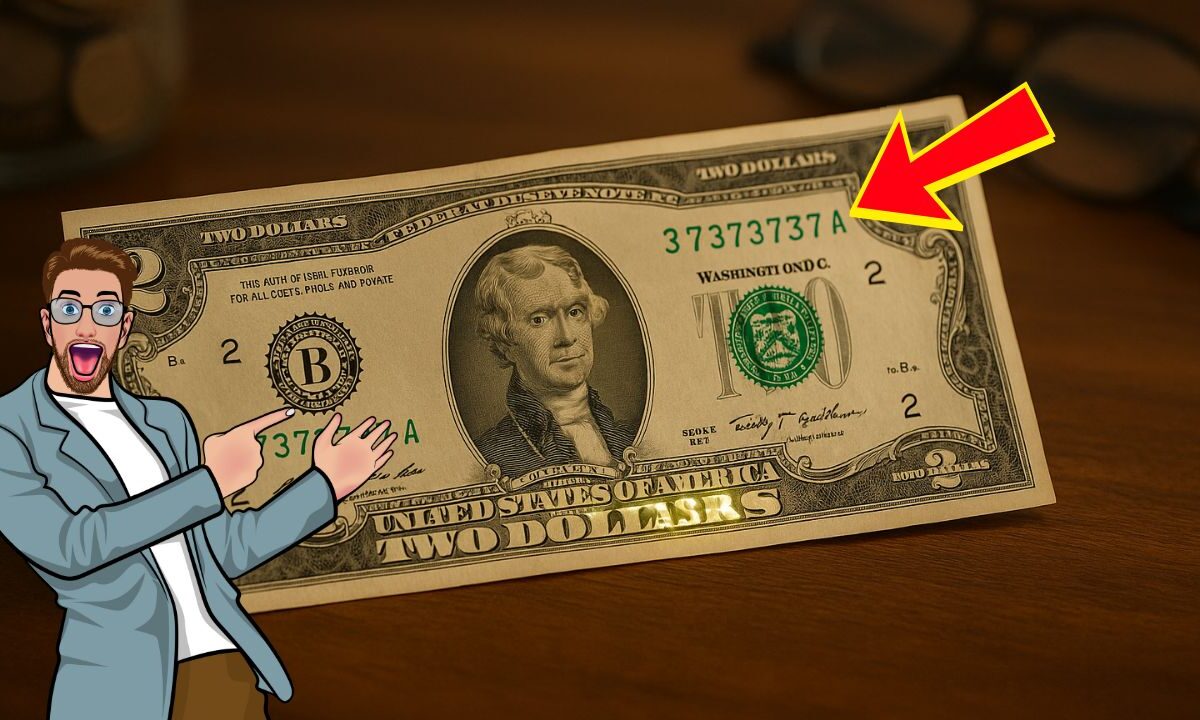For currency collectors, rare bills can be more valuable than gold coins, and the 1975 $2 bill with a repeater serial number has recently made headlines in the numismatic world.
Valued at an astonishing $37,000, this bill has caught the attention of collectors across the United States and even internationally.
Understanding why this bill commands such a high price requires an exploration of its historical significance, unique serial number, and market trends in rare currency collecting.
What is a 1975 $2 Bill?
The $2 bill is a unique denomination in U.S. currency history, first introduced in 1862 as a legal tender note. The modern series, which includes the 1975 Federal Reserve Notes, features Thomas Jefferson on the front and the signing of the Declaration of Independence on the back.
While $2 bills are still in circulation, they are rare to encounter in everyday transactions, making them highly sought after by numismatists and collectors. Their low printing numbers, combined with unique serial numbers, can dramatically increase their value over time.
What is a Repeater Serial Number?
A repeater serial number is a type of fancy serial number where a sequence of digits repeats in a specific pattern. For instance, a bill may have the serial number 12341234 or 56785678.
Collectors prize these serial numbers because they are rare and visually appealing, distinguishing them from ordinary bills. The 1975 $2 bill with a repeater serial number is particularly valuable due to its limited production and the increasing popularity of fancy serial numbers among collectors.
Why the 1975 $2 Bill is Special
Several factors contribute to the high value of the 1975 $2 bill:
- Limited Circulation: Although $2 bills were printed, they were not widely circulated, making surviving bills rarer than other denominations.
- Repeater Serial Number: As mentioned, the repeating digits significantly increase collector interest.
- Excellent Condition: Bills in uncirculated or near-perfect condition fetch higher prices.
- Historical Context: The 1975 series is part of the modern U.S. currency era, linking it to collectors of mid-20th-century notes.
1975 $2 Bill – Market Value
The rare 1975 $2 bill with a repeater serial number recently sold for $37,000, demonstrating the high demand for these notes. Values can vary depending on condition, rarity, and collector interest. Here’s a table outlining typical price ranges for 1975 $2 bills based on serial number type and condition:
| Bill Type | Condition | Average Market Value |
|---|---|---|
| Standard 1975 $2 Bill | Circulated | $4 – $10 |
| Standard 1975 $2 Bill | Uncirculated | $10 – $35 |
| Repeater Serial Number 1975 $2 Bill | Circulated | $500 – $5,000 |
| Repeater Serial Number 1975 $2 Bill | Uncirculated | $20,000 – $37,000 |
| Other Fancy Serial Numbers 1975 $2 Bill | Uncirculated | $1,500 – $25,000 |
As shown, the repeater serial number in uncirculated condition is the most coveted among collectors.
How to Identify a Repeater Serial Number
Identifying a repeater serial number on a $2 bill requires careful attention. Here are some tips:
- Look at the serial number carefully: Repeating patterns may include full or partial repetition of digits.
- Check for symmetry: Many valuable repeater bills feature mirrored patterns (e.g., 12344321).
- Compare with databases: Online numismatic databases and collector forums often track rare serial numbers.
- Evaluate condition: The bill’s mint state, absence of folds, creases, or discoloration increases value.
Collectors often combine serial number rarity with bill condition to assess value.
Historical Significance of the $2 Bill
While the $2 bill has not been widely used, it holds a unique place in American history. The 1975 series, in particular, marked a revival of the $2 denomination as a Federal Reserve Note.
Its historical elements, including Thomas Jefferson’s portrait and the depiction of the Declaration of Independence, make it both a historical artifact and a collectible item.
The introduction of fancy serial numbers in the 1970s further boosted the collectible appeal of these bills. Collectors often see these bills as investments with potential appreciation over time.
Where to Buy or Sell Rare $2 Bills
Collectors interested in acquiring or selling a 1975 $2 bill with a repeater serial number have several options:
- Auction Houses: Sites like Heritage Auctions, Stack’s Bowers, and other reputable auction houses often list rare bills.
- Online Marketplaces: Websites like eBay or specialized currency forums provide access to collectors worldwide.
- Coin and Currency Shows: Physical shows often attract serious buyers and allow direct inspection of bills.
- Private Collectors: Networking with collectors can result in private sales at premium prices.
When selling, it is crucial to certify the bill’s authenticity through a reputable grading service such as PMG (Paper Money Guaranty) or PCGS Currency, as certification can dramatically affect market value.
Factors Affecting the Value
Several factors can influence the value of the 1975 $2 bill with repeater serial number:
- Condition: Uncirculated bills are worth significantly more than circulated ones.
- Rarity: The fewer the bills with a similar serial number, the higher the value.
- Demand: Market trends and collector interest impact pricing.
- Certification: Professional grading increases buyer confidence and sale price.
- Provenance: Bills with documented history often fetch premium prices.
Tips for Collectors
For those interested in investing in rare currency:
- Focus on Serial Numbers: Prioritize repeater, radar, and ladder serial numbers.
- Preserve Condition: Store bills in protective sleeves or currency holders to prevent wear.
- Verify Authenticity: Always use certified graders for high-value bills.
- Stay Updated: Follow auction results to track market trends and emerging values.
- Diversify Collection: Combine historical and rare serial notes for a balanced portfolio.
Recent Sale Highlights
A 1975 $2 bill with a repeater serial number recently sold for $37,000, breaking previous records for this series. The bill was in near-perfect condition, highlighting the importance of preservation and certification. Collectors reported bidding wars online, emphasizing the growing interest in fancy serial numbers.
The 1975 $2 bill with a repeater serial number represents one of the most exciting opportunities for currency collectors today. Its combination of historical significance, rare serial pattern, and excellent condition has elevated its value to an impressive $37,000.
For collectors, understanding serial number types, bill condition, and market trends is essential to identify and invest in these rare treasures. Whether for investment or historical preservation, this bill is a prime example of how rare currency can outperform traditional collectibles.
FAQs
What makes a 1975 $2 bill with a repeater serial number so valuable?
The combination of limited circulation, a visually appealing repeating serial number, and pristine condition makes this bill highly sought after by collectors.
How can I verify the authenticity of a rare $2 bill?
Use professional grading services such as PMG (Paper Money Guaranty) or PCGS Currency, which certify condition and authenticity.
Are all 1975 $2 bills valuable?
No. Standard bills in circulated condition typically sell for $4–$10. Only repeater or fancy serial numbers in uncirculated condition reach premium prices like $37,000.

